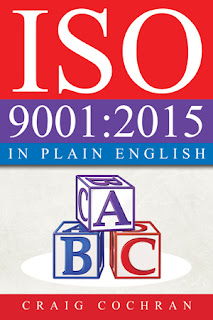ISO 9001:2015 does a lot of things right, but using clear
language is not one of them. One of the most glaring examples is the
transformation of the word “records” into “retained documented information.”
That’s right, they took one word and turned it into three. And the three words
are not nearly as intuitive as the one word they replaced. Regardless of what
you call them, records are the proof of something happening. They are
historical, referring to past events. As such, they are not revised. Records
might be “corrected” in some cases, but they are never revised. Only documents
are revised. (We’ll address documents and their status in ISO 9001:2015 in a
future article.) The primary control of records is that of housekeeping: knowing
where they are stored, who is responsible, how long they’re kept, etc.
Here is a summary of records requirements in ISO
9001:2015:
·
24 records are required in ISO 9001:2015. This
is compared to 21 records required in ISO 9001:2008. Some of the 24 records
required by ISO 9001:2015 are actually repeat requirements.
·
20% of all the record requirements come from section
8.3, Design and development of products and services. That amounts to 5 records,
which is the same number required by ISO 9001:2008.
·
A completely new record that is required in
9001:2015 is retained information on changes: review of changes, persons
authorizing the change, and necessary actions arising from change (section
8.5.6)
·
ISO 9001 continues its redundant ways. ISO
9001:2015 requires records of evidence of processes being carried out
effectively TWICE, once in section 4.4.2 and again in section 8.1.e.1.
·
More redundancy: ISO 9001:2015 requires records
that demonstrate conformity of products & services processes TWICE, once in
section 8.1.e.2 and again in section 8.6.
·
5 of the records in ISO 9001:2015 have
qualifiers. They are “to the extent necessary” and “as applicable.”
·
One item listed as “retained documented
information” (i.e., record) is actually a document. That is design outputs.
Design outputs are living information such as specifications, engineering
drawings, recipes, formulas, and bills of material. Since they are living, they
are subject to revision, meaning they are documents.
·
A handful of requirements would be virtually
impossible to have evidence of without records, and yet records are not
required by ISO 9001:2015. These include context of the organization (4.1),
interested parties (4.2), planning of changes (6.3), and customer feedback
(9.1.2).
·
One of the strangest record issues of all is the
omission of calibration records in ISO 9001:2015. This has been replaced by the requirement to ‘retain
information on fitness of purpose for measuring instruments,’ which would include calibration. I expect many people implementing ISO 9001:2015 will get a bit confused by this.
Do not let anyone tell you that the “correct” terminology
is retained documented information. If you like that term, then by all means
use it. If you prefer the term ‘records,’ you can use that in its place. Always
remember that documents are records are two different things. That one fact
alone will make any QMS easier to use and understand.







